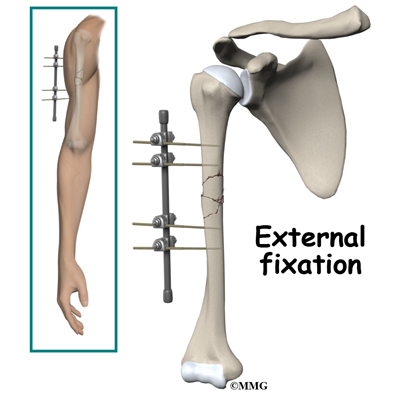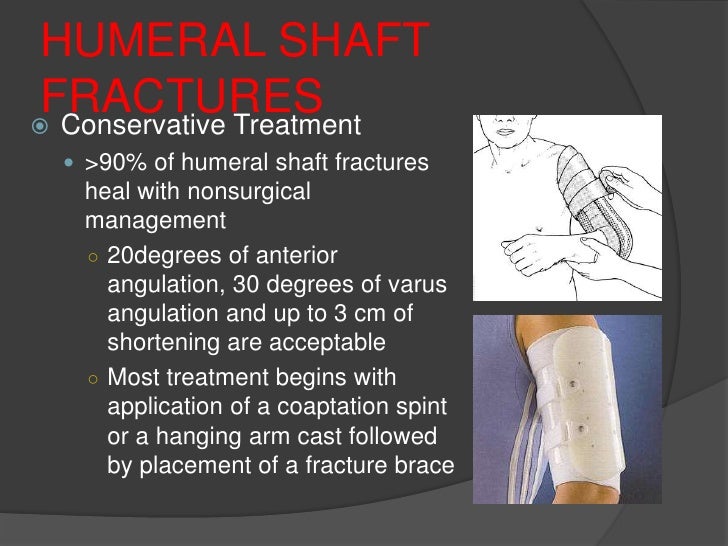
#Splinting humerus fracture skin
One should also evaluate the skin integrity if there is an overlying laceration, it is classified as an open fracture. On exam, it is important to evaluate for skin tenting, motor function distal to the injury, sensation distal to the injury, and pulse and/or capillary refill distal to the injury. Also, patients may have a deformity to the upper arm, shortening of the extremity, swelling, and/or bruising. Patients will present with arm pain after traumatic injury. It is also very important to confirm that the patient’s distal pulses and capillary refill are intact, as the brachial artery also traverses the humerus in proximity to the radial nerve and the above listed anatomic landmarks. Of note, radial nerve paralysis is rare in children with humeral fractures, though neuropraxia can still occur, also with a resolution of symptoms in three to four months. Up to 90% of patients with a closed humeral fracture with radial nerve injury will have a resolution of neuropraxia within three to four months following the injury. On physical exam, patients with a radial nerve injury may have wrist drop (loss or weakness of wrist extensors), loss or weakness of finger extension, and decreased or absent sensation to the posterior forearm, digits 1 to 3, and the radial half of the fourth digit.

The radial nerve is most likely to be damaged in humerus fractures that have a lateral displacement of the distal fracture segment, as the nerve is tethered to the bone and cannot withstand the forces applied to it as a result of the displacement. The spiral groove is located about 14 cm proximal to the lateral epicondyle and 20 cm proximal to the medial epicondyle. It crosses through the spiral groove on the posterior side of the humerus shaft. The radial nerve originates in the brachial plexus and has nerve roots from C5 to T1. In open humerus fractures, the incidence of radial nerve laceration is much higher at 60%. In closed fractures, radial nerve injury is most commonly an incomplete neuropraxia rather than a complete laceration of the nerve. Radial nerve injury occurs in approximately 18% of closed mid-shaft or distal shaft humerus fractures.

The most important clinical pearl associated with midshaft humerus fractures involves injury to the radial nerve. Sixty percent of all humeral fractures occur in the middle-third of the humerus. Peak incidence occurs in males aged 21 to 30 and females aged 60 to 80, although a humerus fracture could happen in persons of any age or gender with the right mechanism of injury. In the elderly, it can also occur from a fall on the outstretched arm, where the humerus takes the brunt of the injury instead of the wrist. Most frequently, fractures are a result of trauma, such as a fall, motor vehicle accident, or motorcycle accident. Musculocutaneous, median and ulnar nervesĪ fracture that occurs at the midshaft of the humerus usually occurs due to a direct blow to the upper arm.Biceps brachii, brachialis, coracobrachialis.The humeral shaft is surrounded by large arm muscles, blood vessels and include the following: The majority of humeral shaft fractures are unstable but non-surgical treatment is the standard of care. These fractures are classified based on their location, open or closed status and the type of fracture line. Humeral shaft fractures account for about 3% of all fractures. Employ interprofessional team strategies for improving care coordination and communication to advance the treatment of humeral shaft fractures and improve outcomes.Ī direct blow commonly causes fractures that occur in the middle third of the shaft of the humerus.

List the treatment and management options available for humeral shaft fractures.

Describe the presentation of a patient with a humeral shaft fracture.Describe the etiology of humeral shaft fractures.This activity outlines the cause of midshaft humeral fractures, reviews their evaluation and management, and highlights the role of the interprofessional team in managing patients with this condition. In the elderly, this fracture can also occur due to a fall on an outstretched arm. Midshaft humeral fractures usually occur due to a direct blow to the upper arm, which commonly results from falls, motor vehicle accidents, or motorcycle accidents.


 0 kommentar(er)
0 kommentar(er)
